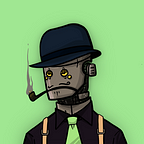Have you ever felt like your vote doesn’t really matter in the grand scheme of things? Or that the topic is a boring or very difficult one? That’s a common sentiment, but what if there was a way to incentivize participation in governance processes by gamifying the experience? That’s the idea behind Proof of Chaos, a project that wants to encourage voting in Kusama Governance (Democracy referendums) by offering non-fungible tokens (NFTs) as rewards.
How does it work?
The mechanic that Proof of Chaos uses is simple. It adds quest/RPG elements into the process of governance voting, rewarding the voter/player for each action taken. And it is making them come back for more by introducing new features or evolving previously owned NFTs if certain conditions are met (like having voted in the past 25 referendums).
The protocol airdrops an NFT to a voter’s wallet as a thank-you for making part of the governance process. This airdrop follows some rules: The rarity of the NFT you receive will be determined by a “luck factor,” which can be influenced to some extent by the voter.
For example, you can click on “Take Quiz” on their website and answer questions about the proposal. Choosing the right options will increase your chance of getting an NFT of improved rarity.
Or when selecting your voting option by choosing to lock more funds in democracy for longer periods. That also increases the odds of receiving a rarer NFT.
Even having a specific NFT from their collection can give you an extra boost!
The Collection
Any first-time voter will receive a Shelf NFT (besides the Item NFT for that Referendum). This Shelf NFT can receive “or nest” Items NFTs inside it. It is where each personal collection is displayed, providing a visual recognition of participation in the system’s governance.
By adding new items to the personal collection, voters can be entitled to better drops and additional rewards from partners (Evrloot, for example). If missing an Item NFT, they can buy it from the secondary market at the Singular NFT Marketplace.
As briefly mentioned before, the item NFTs can “evolve.” This added layer of interaction creates an exciting “game” element, encouraging users to engage more deeply with the governance process and potentially even learn more about the issues at hand. For example, an egg received in Referendum 192 became a baby dragon if certain conditions were met.
And as the protocol evolves, also the conditions. This keeps the interaction attractive as new incentives are added along the way. For example, the latest dragon evolution will be sent to the TOP 25 places on the voting leaderboard.
The tech enabling it
And how can their team handle all this flexibility to keep adding new features, conditions, and keep stacking NFTs? One of the tools they use is the RMRK NFT Standard.
RMRK is a platform that allows users to create NFTs that are not just static images but rather “building blocks” that can interact with other NFTs or with external conditions. This means that the appearance or behavior of an RMRK NFT can change based on certain inputs or triggers. For example, an RMRK NFT could be a digital artwork that changes its appearance based on the time of day, the weather, or other external conditions. Or, it could be a game piece that changes its behavior based on how it is used or combined with other game pieces.
RMRK provides five primitives (or features) for builders to make up complex use cases and enable certain concepts. Proof of Chaos is using extensively two components of the RMRK protocol. Its Shelf leverage the ability of any NFT to contain other RMRK NFTs. That’s how new Items NFTs can be added to it, and the voter can manage which ones to display on the shelf.
The dragon evolution (starting with the egg up to an adult dragon) uses the power of an NFT to vary its output depending on the context. Proof of Chaos added new resources (images) to voters who met the required conditions.
In Conclusion
Proof of Chaos uses the power of RMRK NFTs to gamify governance participation and incentivize voting in proposals. This strategy to increase voting participation can be effective because it adds an element of fun and reward to the process. In addition, offering NFTs as incentives for participating in governance processes creates an additional layer of motivation for voters to get involved, as it allows for a clear and visual representation of an individual’s participation and progress within the system. This can create a sense of accomplishment and encouragement for voters to continue participating to improve their standing and collection of NFTs.
